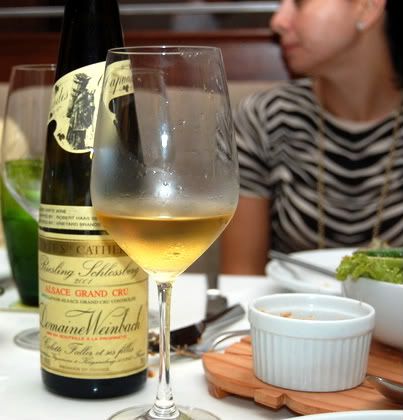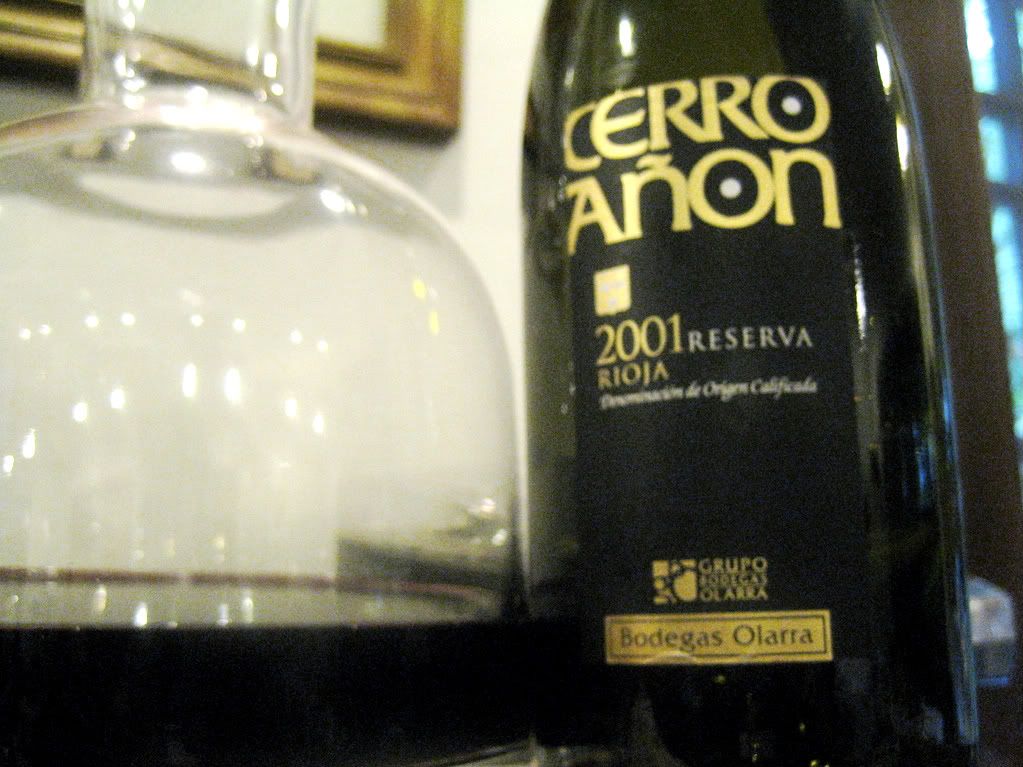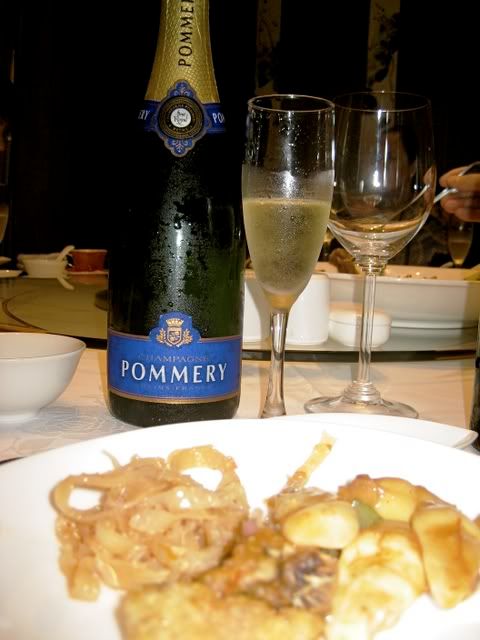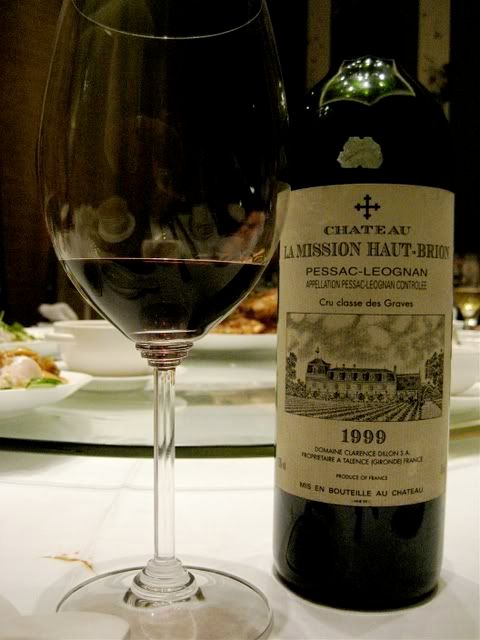~ At Premium Wine Exchange, 16 August 2008 ~


Though all the Grand Crew's challenges are inherently occasions to look forward to, this one was special in that it was the 10th; moreso for the Vigneron as this year is his and Mrs. Vigneron's 10th year wedding anniversary. That, and considering the couple recently returned from Bordeaux, we knew the Vigneron had something particularly dangerous up his sleeve. I warned him, though, that the moment I detected a mature Margaux, I'd automatically relegate it to last place.
Unfortunately, my relatively new phone crashed a few weeks ago, taking my entire schedule with it. I forgot about the date and ordered my competition bottles late - they arrived by airfreight only a few days before the Challenge and didn't have enough time to "rest" and stabilize.
Thus, I was limited to what I had in my old stock - good wines, to be sure, but either too young (research shows that Médocs from the '80s to 1990 in general, with a few late-90s right banks thrown in, usually prevail with this group) or too old (no Bordeaux below 1982 has ever won in our "competition". The best sub-'80s ever did was 2nd Place (i.e., my
1979 Pichon Lalande and even the Vigneron's
1961 Pichon Lalande).
I was discussing these matters with the Stockbroker via text the day before the competition. He seemed undaunted in the face of the Vigneron's determination and advised me not to worry about bringing a younger wine. I heeded his advice and chose a right bank from a recent, but very ripe and heralded vintage from my stash.

The appointed date came, and we gathered at the romantic evening environs of Premium Wine Exchange (the venue of the very first Challenge, the first week of June 2005, dinner by the Miguel Brothers, which the Vigneron won with a 1982 Pichon Lalande). This time, young and very accomplished chef,
Tippi Tambunting, prepared a sumptuous feast. I've attended many dinners executed by Tippi, and enjoyed them all. This time, though, she really outdid herself.
Those who want to try her cuisine can contact her at
0918 811 8088. She'll come to your home (or other chosen venue) and prepare you an excellent meal with well-trained staff and all the correct flatware and stemware to boot! She absolutely frees the host of a fine dining event from all the usual hassles and pressure, leaving him/her all the time to entertain guests and enjoy - take it from me, I know.
As the Doc was runing late at the hospital, we kicked things off with some pass-arounds which included a particularly delicious
Shrimp and Young Asparagus Frittata which we all enjoyed with the Stockbroker's:
 Cerdon de Bugey Caveau de Mont St-July (NV, Méthode Ancéstrale)
Cerdon de Bugey Caveau de Mont St-July (NV, Méthode Ancéstrale) - I first discovered this unpretentiously pink, brilliantly effusive, poulsard-and-gamay based, off-dry, strawberry-dominant, non-vintage bubbly from the mountains of France's Jura region (near the Swiss border) in Alain Ducasse's Paris bistro,
Aux Lyonnais, in early June 2006.
I brought in some bottles shortly thereafter and it was an instant hit with the ladies - especially with my wife, Mrs. Doc and Mrs. Vigneron. I recall after the latter first tried a couple of glasses, she told me to keep it away from her as she would drink the whole bottle. What better compliment could there be for a wine?
After a while, we seated ourselves to an absolutely delightful and comforting
amuse bouche of
Fried Baby Potatoes, Crunchy Chorizo Bits Topped with a Fried Quail Egg. Being a lover of Filipino breakfasts, I jokingly asked if there happened to be a couple of tablespoons of sinangag lying around in the kitchen. I enjoyed it so much, I ate it all in two bites (only because I was trying to mind my table manners, otherwise I'd have stuffed the whole thing in my mouth) and, consequently, forgot to take a picture of it.
By that time, the Doc had finally arrived, so dinner proper began.
The first course was an excellent
Cream of Tomato Soup with Puff Pastry. With this, and for the fish course, I opened a bottle of my:
 1999 Domaine JM Brocard Chablis Grand Cru "Les Clos"
1999 Domaine JM Brocard Chablis Grand Cru "Les Clos" - My bottle. The domaine of Jean-Marc Brocard is a traditional maker in the minimal oak school of Chablis - which inherently puts it on my buy list. I visited the domaine in mid-2006 - my wife and I just walked in without an appointment - they didn't know me from Adam and were already entertaining a busload of British tourists.
Direct to the point, I told the lady there that I was only interested in their grand crus. After a quick word with a colleague, she proceeded to open several fresh bottles of their grand crus (les Clos, Bougros, Valmur and les Preuses) as well as a couple of premier crus (Montmains and Vaillons). I bought quite a few of them to lug home.
Plump but barely firm enough on the palate, with soft, ripe green apple and pear, slight touches of lemon curd, oyster shell, minerals and vanilla. Nice medium curves. Pretty good depth of fruit and complexity. The balance, however, was just slightly above average, I felt it needed a bit more structure and lifting acidity - but then I personally prefer the leaner, edgier premier crus than richer, fuller grand crus. In all, pretty good, but was eclipsed by the tomato soup.
The second course was Mixed Greens topped with
Crispy Pancetta and Brie de Mieux, followed by the third course of
Crispy Skin Sea Bass with Leek Fondue and Balsamic Glaze which we all enjoyed with:
 2005 Cuvée du Vatican Chateauneuf-du-Pape Reserve Sixtine Blanc
2005 Cuvée du Vatican Chateauneuf-du-Pape Reserve Sixtine Blanc - the Stockbroker's bottle, a wine I've enjoyed twice before in January and May 2008. My notes of 20 January 2008 state:
Initially tightly-wound, it would reveal only
laser-clean steely white minerals with some flint in its compact white fruit. I
guessed (correctly) it was more roussanne. Later on, it expanded and fleshed out generously,
displaying broad, almond cream, vanilla/oak laced ultra ripe fruit (something
like baked apple and pear) with a slight whisper of peach. Much, much bigger and
fuller and heavier than the previous wine. I then guessed, wrongly, that it was
more marsanne. Oh, well... I must have over-thought myself to error.
These old notes were re-confirmed by the subject bottle. I may add that after a bit of breathing in glass, the wine released a most captivating bouquet of mildly spiced (I detected hints of cinnamon and nutmeg) wild honey, white flowers , toasty oak/vanilla and baked apple. The middle was very broad and luxurious.
An excellent white CdP and I am very happy that it is readily available at Premium Wine Exchange. Those who wish to explore CdP blancs will be extremely hard pressed to find a better wine than this in the Philippines.

As to the pairing, it was a good match - sea bass is a robust fish that needs a fuller, luxurious white - a prescription the subject bottle easily fills. I suggest this be decanted and the decanter put in a bucket of moderately iced water for around 20-25 minutes to allow for breathing at proper temperature so it may fully release its charms.
Before the main course, we had a mild Poached Peach Sorbet. I do not usually indulge in sorbets before tasting reds to preserve my palate, but, in this case, after a rich fish and white, I needed to palate-cleanse. Fortunately, Tippi thought to serve a peach-based sorbet, rather than a berry-based one (the latter are usually too tart and strong and leaves an overly long aftertaste on the palate - not good for wine-tasting). This sorbet was mild and more neutrally flavored and, together with rinsing with water, cleansed the palate very nicely.
In the meantime, all the competing reds had been presented.

With
Braised Snake River Farm Wagyu Beef Cheeks with Open Mushroom Ravioli, Bone Marrow and Wilted Spinach:
Wine # 1 - Immediately and easily the most openly captivating bouquet of all the entrants with a perfumed theme of wet sweet tea leaves (also noted by the Stockbroker), mild Spanish cedar, whisper of camphor, licorice, dark plum. On the palate, it was comfortingly warming, broad, plush, expansive, yet decently focused, with dark spice-infused cassis, molten dark/red berries, touch of plum, mild licorice, toasty oak, sweet tea leaves and chocolate undertones. After more breathing, I detected a delicate toffee nuance at the end.

Definitely a crowd-pleaser. This, to me, from my first pass to my last, was easily the best wine of the night, and I ranked it 1st Place.
It turned out to be the Stockbroker's 1990 Léoville Poyferré - made several years before Michel Rolland's services were engaged, considered by many to be the best wine Poyferré has ever produced. Having had several other vintages from this château, I must agree with such assessment.
 Wine # 2 - Slight band-aid on the otherwise delicate, minerally nose. The band-aid subsided after several minutes revealing faint, sweetish scents of dark violets, gravel, earth, minerals, cassis and cedar (my wife noted it as the best nose of the night, while the Doc and the Stockbroker thought its nose was muted). All these were mirrored on the palate with a dark plummy underbelly and the sweet cedar more pronounced late-mid-palate and, the violets surfacing more towards the back.
Wine # 2 - Slight band-aid on the otherwise delicate, minerally nose. The band-aid subsided after several minutes revealing faint, sweetish scents of dark violets, gravel, earth, minerals, cassis and cedar (my wife noted it as the best nose of the night, while the Doc and the Stockbroker thought its nose was muted). All these were mirrored on the palate with a dark plummy underbelly and the sweet cedar more pronounced late-mid-palate and, the violets surfacing more towards the back.
Admirable finesse and complexity, but comparatively too light on the palate after the previous wine. It had the misfortune of being tasted immediately after Wine # 1. Wine # 2 was an elegant wine, to be sure, delicate and feminine, but was a bit too fine and delicate to be served right after the previous lush and generous wine. I eventually ranked it 3rd Place. Mrs. Doc and Mrs. Stockbroker, however, ranked it 1st Place, while the Vigneron and my wife ranked it 2nd Place.
It turned out to be the Vigneron's 1983 Palmer - again, reputedly one of the best the château has made. I must mention, though, that my bottle of their 1989, one of their other heralded vintages, failed to impress me to any great extent.
Wine # 3 - Full, rich, extracted and a lot of plumminess to its dark molten cherry/kirsch/dark fruit and creamy cassis, with pronounced espresso notes. The Doc noted hints of leather, we both wrote down the descriptor "velvety' in our respective notes. Very broad mid-palate with precise heft just short of legitimate full-bodiedness.
 Not much of a bouquet, a bit reticent to me, but absolutely pleasing in the mouth. The Vigneron, Stockbroker and I mis-identified it as a wine from the right bank. I ranked it 2nd Place, as did Mrs. Vigneron and the Doc.
Not much of a bouquet, a bit reticent to me, but absolutely pleasing in the mouth. The Vigneron, Stockbroker and I mis-identified it as a wine from the right bank. I ranked it 2nd Place, as did Mrs. Vigneron and the Doc.
We were all surprised when it was revealed to be the Doc's 1988 Lynch Bages. I must state that we were very impressed with how young this 20-year old wine tasted.
Wine # 4 - Densely red with simple aromas of sweet red berries, sweet camphor and cedar and oak/vanilla. In the mouth, it was firmer and more focused than Wine # 3, but the latter is broader and has a better body. There is decent minerality, cedar and espresso, dominated by raspberry and dark cherry through the finish.
 Mrs. Vigneron noted a pronounced vanilla/oak flavor while her hubby noted it as a right bank, too young and lacking in finesse. The Doc and Stockbroker also correctly pegged it as a right bank.
Mrs. Vigneron noted a pronounced vanilla/oak flavor while her hubby noted it as a right bank, too young and lacking in finesse. The Doc and Stockbroker also correctly pegged it as a right bank.
Mr. and Mrs. Stockbroker ranked it 2nd place. I and Mrs. Vigneron ranked it 4th Place.
It was later on revealed as my 2000 Figeac.
 Summary of My Own Results
Summary of My Own Results:
1st Place - the Stockbroker's 1990 Léoville Poyferré
2nd Place - the Doc's 1988 Lynch Bages
3rd Place - the Vigneron's 1983 Palmer
4th Place - my 2000 Figeac
Group's Official Results:
And so, it came to pass that a new King was crowned....

1st Place - the Stockbroker's 1990 Léoville Poyferré by a landslide with 28 points (6 votes for 1st, 1 vote for 2nd, 0 votes for 3rd and 1 vote for 4th).
2nd Place - the Vigneron's 1983 Palmer with 21 points (2 votes for 1st, 2 votes for 2nd, 3 votes for 3rd and 1 vote for 4th).
3rd Place - my 2000 Figeac with 16 points (0 votes for 1st, 2 votes for 2nd, 4 votes for 3rd and 2 votes for 4th).
4th Place - the Doc's 1988 Lynch Bages with 15 points (0 votes for 1st, 3 votes for 2nd, 1 vote for 3rd and 4 votes for 4th).
The evening was brought to a close by a rich yet refreshing Pavlova with Mascarpone Cream and Mixed Berries.

Hail to the King, may his victory be as sweet, but, hopefully, not too long-lived...as the pressure mounts.

 2005 Bott-Geyl Les Pinots d'Alsace Metiss - As I understand from Jérome, this is a blend of pinot blanc, pinot noir, pinot gris and auxerrois (not to be confused with the auxerrois of Cahors which is what they call the malbec grape there).
2005 Bott-Geyl Les Pinots d'Alsace Metiss - As I understand from Jérome, this is a blend of pinot blanc, pinot noir, pinot gris and auxerrois (not to be confused with the auxerrois of Cahors which is what they call the malbec grape there).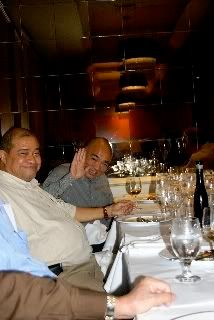 2006 Bott-Geyl Gewürztraminer Les Elements - This wine was supposed to have been served with the munster cheese tart with salad, but, somehow, the it was served with the flammenkueche - Rene Fuentes - he of the basso profundo - made sure everyone caught the vinous faux pas. The dish, also known as "tarte flambée", is, simplistically, like a thin-crust pizza without tomato sauce, topped with various ingredients, but, traditionally, these ingredients are crème fraîche, fromage blanc (a soft, fresh cream cheese that looks like sour cream), onions and lardons (bacon that is diced, blanched and fried).
2006 Bott-Geyl Gewürztraminer Les Elements - This wine was supposed to have been served with the munster cheese tart with salad, but, somehow, the it was served with the flammenkueche - Rene Fuentes - he of the basso profundo - made sure everyone caught the vinous faux pas. The dish, also known as "tarte flambée", is, simplistically, like a thin-crust pizza without tomato sauce, topped with various ingredients, but, traditionally, these ingredients are crème fraîche, fromage blanc (a soft, fresh cream cheese that looks like sour cream), onions and lardons (bacon that is diced, blanched and fried). 2001 André Ostertag Riesling Cuvée Clos Mathis - Decanted and kept chilled for over an hour before serving to allow it to fully open and be at its best when served, said Bernie, relating to me how this wine just kept better and better during the tasting lunch's span (the one that I missed - sure, sure, make me jealous).
2001 André Ostertag Riesling Cuvée Clos Mathis - Decanted and kept chilled for over an hour before serving to allow it to fully open and be at its best when served, said Bernie, relating to me how this wine just kept better and better during the tasting lunch's span (the one that I missed - sure, sure, make me jealous). 1989 André Ostertag Gewürztraminer Fronholz Sélection de Grains Nobles - the phrase "Sélection de Grains Nobles" (SGN) is a term used in Alsace and Monbazillac (and perhaps elsewhere in France, I don't know) indicating that the grapes were heavily subjected to botrytis cinerea (much more than vendanges tardives) to shrivel them and concentrate their natural sugars. The same process yields the better known sweet wines of Sauternes and Barsac (which use semillon, sauvignon blanc and, to a much lesser extent, muscadelle grapes).
1989 André Ostertag Gewürztraminer Fronholz Sélection de Grains Nobles - the phrase "Sélection de Grains Nobles" (SGN) is a term used in Alsace and Monbazillac (and perhaps elsewhere in France, I don't know) indicating that the grapes were heavily subjected to botrytis cinerea (much more than vendanges tardives) to shrivel them and concentrate their natural sugars. The same process yields the better known sweet wines of Sauternes and Barsac (which use semillon, sauvignon blanc and, to a much lesser extent, muscadelle grapes). Dinner done, we accorded Marc and his staff the proper thanks and respect, and wound down with espressos, glasses of kirsch and, for some, cigars. It was an incredibly busy evening at Gourmand - the place was absolutely packed, and it wasn't just us, I saw several friends there including steak tartare addict Miguel at one table and my youngest sister on a date at another.
Dinner done, we accorded Marc and his staff the proper thanks and respect, and wound down with espressos, glasses of kirsch and, for some, cigars. It was an incredibly busy evening at Gourmand - the place was absolutely packed, and it wasn't just us, I saw several friends there including steak tartare addict Miguel at one table and my youngest sister on a date at another.






